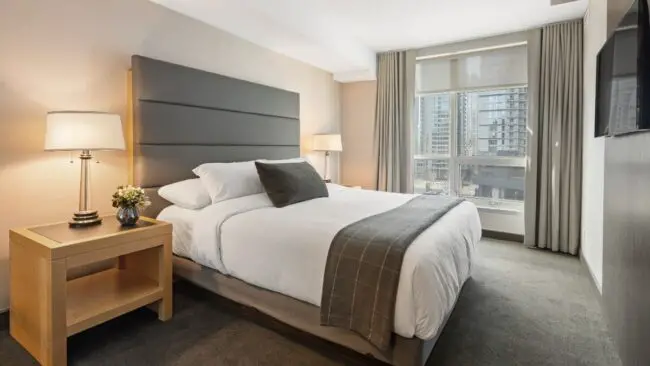Do hotel rooms always seem to blend together? Have you ever wondered why there is such uniformity in hospitality design? In this blog article, we will delve into the intriguing world of hotel room aesthetics and explore the reasons behind their striking similarities.
From the layout to the furniture, we will discover the factors that contribute to the homogeneous nature of hotel rooms. So, if you’ve ever pondered, “Why do all hotel rooms look the same?” – join us on this journey as we unravel the secrets behind the uniformity of hospitality design. Let’s get started!
Table of Contents
Why Do All Hotel Rooms Look the Same? Exploring the Uniformity of Hospitality Design
When you step into a hotel room, whether it’s in a budget hotel or a luxury resort, you often notice a striking resemblance to other hotel rooms you’ve been in before. The furniture, layout, amenities, and overall design seem to follow a familiar pattern.
But have you ever wondered why all hotel rooms look the same? In this article, we will delve into the concept of uniformity in hospitality design and explore the factors that contribute to this phenomenon.
The Importance of Consistency in Hospitality
One key reason behind the uniformity of hotel rooms is the need for consistency in the hospitality industry. Hotels aim to provide a predictable experience for their guests, regardless of the location they visit.
By following a standardized design, hotels can ensure that guests feel comfortable and familiar in any of their properties. This consistency helps build brand loyalty and allows guests to know what to expect when they book a room.
Economies of Scale
Another factor driving the uniformity of hotel rooms is the concept of economies of scale. Hotel chains often own multiple properties, spanning various locations. Designing and furnishing each room uniquely would be time-consuming and expensive.
By adopting a standardized design, hotels can streamline their operations and take advantage of bulk purchases. This approach allows them to reduce costs and maintain profitability.
Read More: About Can You Bring Microwave Popcorn on a Plane?
Efficient Space Utilization
Space utilization is a crucial consideration in hotel design. Hotel rooms need to accommodate a variety of guests, from solo travelers to families. By maximizing the use of space, hotels can ensure that their rooms are functional and efficient.
The standardized layout of hotel rooms optimizes the use of available space, making it easier to allocate furniture, amenities, and storage solutions in a consistent manner.
Guest Comfort and Convenience
Uniformity in hotel room design also takes guest comfort and convenience into account. Guests expect certain amenities and features to be readily available in their rooms, regardless of the hotel’s location.
By adhering to a standardized design, hotels can ensure that each room meets the expectations of their guests. This includes amenities such as comfortable beds, well-designed bathrooms, sufficient lighting, and adequate storage space.
Brand Identification and Recognition
Hotels strive to create a strong brand identity that guests can easily recognize. Uniformity in design plays a significant role in achieving this goal. When hotel rooms across different locations look similar, guests can quickly associate them with the brand they trust.
This branding strategy helps hotels stand out in a competitive market and reinforces their reputation for quality and consistency.
Changes in Guest Preferences
Over the years, guest preferences and expectations have evolved. Hotels have adapted to these changes by incorporating new design trends and amenities. However, while there may be variations in the finer details, the underlying layout and overall design remain relatively consistent.
By striking a balance between innovation and familiarity, hotels can cater to evolving guest preferences while maintaining a sense of uniformity.
Operational Efficiency
Uniformity in hotel room design simplifies the management and maintenance of properties. When all rooms follow a standardized layout, it becomes easier for staff to clean, maintain, and prepare rooms for new guests. This operational efficiency allows hotels to deliver consistent service and ensure that rooms are always ready for occupancy.
It also facilitates staff training, as employees can quickly become familiar with the layout and organization of each room.
Market Research and Guest Feedback
Hotels invest significant resources in market research and gathering guest feedback. These insights play a crucial role in shaping hotel room design. By analyzing guest preferences, hotels can identify the elements that are most important to their target audience. This information is then used to refine and optimize the standardized design, ensuring that it continues to meet the evolving needs and expectations of guests.
The uniformity of hotel room design exists to provide guests with a consistent, comfortable, and recognizable experience. It allows hotels to efficiently manage their properties, reduce costs, and build a strong brand identity. While variations may exist, the underlying design principles and layout remain largely unchanged.
So, the next time you step into a hotel room and notice its familiar design, remember that it is a result of careful consideration and a desire to create a memorable and consistent guest experience.
Read More: About How to travel with a baby in a taxi?
Frequently Asked Questions (FAQs)
Hotel rooms often have a similar design to provide a consistent experience for guests. The uniformity in hospitality design serves several purposes, including:
To meet guests’ expectations: Many travelers have certain expectations when it comes to hotel rooms, such as comfortable beds, functional layouts, and specific amenities. By following a standardized design, hotels can ensure that these expectations are met.
To optimize space: Hotel rooms are typically designed to make the most efficient use of available space. A standardized layout allows hotels to maximize the number of rooms they can accommodate within a given area.
To streamline operations: Standardized room designs make it easier for hotel staff to clean, maintain, and service the rooms. This efficiency helps hotels provide consistent quality and minimize downtime.
To enhance branding: A consistent design across multiple locations helps reinforce a hotel brand’s identity. Guests may feel more comfortable and loyal to a brand they know and recognize.
The impact of uniformity in hotel room design on guest experience can be both positive and negative:
Positive impact: Familiarity can provide a sense of comfort and reassurance for guests. Knowing what to expect in terms of layout, amenities, and overall design can make travelers feel more at ease during their stay.
Negative impact: Some guests may find uniform hotel room designs monotonous or lacking in uniqueness. It may result in a less memorable experience for those seeking a more personalized or boutique-style accommodation.
While many hotel rooms follow a standardized design, there are variations that can be found:
Branded hotels: Different hotel brands may have their own unique design concepts and themes. This allows them to maintain consistency within their brand while also offering distinct experiences across different locations.
Boutique hotels: Boutique hotels often have more diverse and individually designed rooms, catering to guests seeking a more unique and personalized experience.
Luxury hotels: Luxury hotels may feature more extravagant and customized room designs, offering high-end amenities and unique architectural elements.
Local influences: Hotels located in culturally rich or historically significant areas may incorporate local influences into their room designs to create a sense of place.
Yes, hotels maintain uniformity due to several reasons:
Consistency: A consistent design helps reinforce a hotel brand’s identity, enabling guests to recognize and associate it with a certain level of quality and service.
Efficiency: By following a standardized design, hotels can streamline their operations, optimize housekeeping routines, and efficiently maintain and service the rooms.
Guest expectations: Many travelers expect certain amenities, layouts, and designs in their hotel rooms. Maintaining uniformity allows hotels to meet these expectations consistently.
Cost-effectiveness: Standardized room designs can be more cost-effective in terms of construction, procurement, and maintenance. Bulk purchasing of materials and equipment can lead to lower costs.
While unique and individually designed hotel rooms can be attractive to certain guests, there are considerations that make uniformity more prevalent:
Guest expectations: Many travelers prefer a consistent experience and familiar environment when staying at hotels. They may value comfort, functionality, and a predictable layout over unique design features.
Efficiency: A standardized design allows for more efficient housekeeping and maintenance processes, reducing downtime and ensuring a smoother operation.
Brand recognition: Uniform room designs contribute to building a strong brand identity and recognition, which can be essential for hotel chains and larger hospitality groups.
Cost considerations: Developing unique designs for every hotel room would be costly, and those expenses might be passed on to guests through higher room rates.
While uniformity is still prevalent in the hotel industry, there is also a growing trend towards more diverse and unique room designs:
Boutique hotels: The rise of boutique hotels, with their emphasis on individuality and unique experiences, has paved the way for less standardized room designs.
Themed hotels: Some hotels are embracing distinct themes or concepts, creating immersive and memorable experiences for guests.
Technology advancements: Advancements in technology, such as customizable room features and interactive displays, allow hotels to offer more personalized and tailored experiences.
Increased competition: To stand out from the competition, hotels are exploring innovative and visually appealing room designs that differentiate their properties.
Hotels can strive for a balance between uniformity and uniqueness by considering the following:
Standardize key aspects: Maintain consistency in essential elements such as bed quality, cleanliness, and service standards, while allowing room for diversity in design and decor.
Introduce themes or variations: Hotels can create different room themes or categories within their properties to offer guests a choice of unique experiences while still maintaining overall consistency.
Embrace local influences: Incorporate local culture and design elements into room decor to provide a sense of place and create a more authentic experience for guests.
Utilize technology: Implement technology solutions that allow guests to personalize their room settings, and offer a more tailored experience within a standardized framework.
Final Thoughts
Hotel rooms often appear strikingly similar, leaving many travelers wondering why there is such uniformity in hospitality design. The repetition of patterns, color schemes, and furniture layouts can make it challenging for guests to differentiate one hotel from another. The reason behind this lies in the desire to create a consistent and familiar experience for guests, regardless of the location. Hotel chains strive to provide a standardized level of comfort, convenience, and functionality.
This approach helps guests feel at ease and confident in their choice of accommodation. So, why do all hotel rooms look the same? It’s simply a way to ensure a reliable and predictable experience for travelers.






